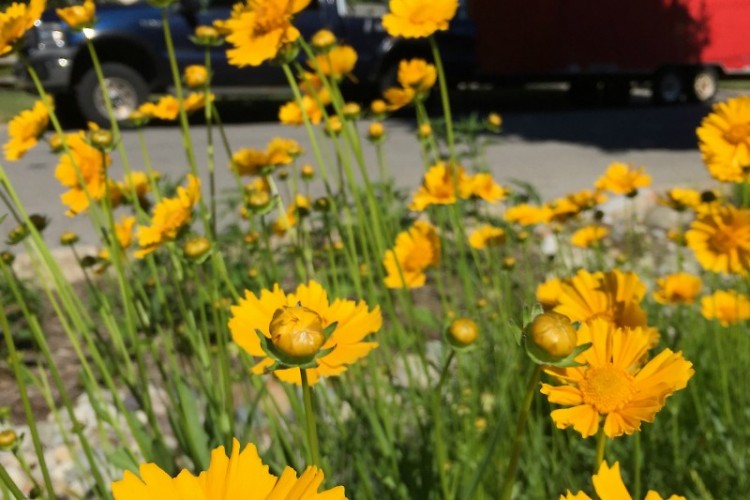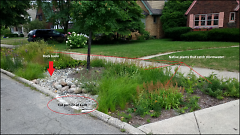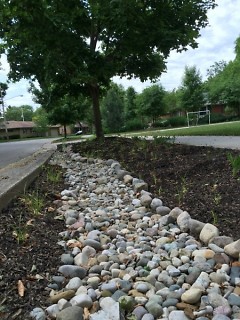It is the summer of 2014, and rain has begun to fall on a hot July afternoon in West Michigan. One droplet lands on a rooftop in the Alger Heights neighborhood, running down the sloped roof into the gutter and through the downspout onto the driveway. There it makes its way downslope to the hot, hard surface of Paris Avenue, on its way picking up herbicide used by a homeowner and a little gasoline from a leaky car. The droplet now finds itself heading to a storm drain where it is whisked off, not to a sewage treatment plant (as is often assumed), but into the nearest waterway which in this case is the highly contaminated Plaster Creek.
Once in Plaster Creek the water droplet joins countless others that also come from impermeable surfaces thanks to the built environment of Grand Rapids. The creek flows under street after street, rapidly gaining volume as it collects more and more runoff infused with pollutants picked up along the way. It also erodes large volumes of sediment from the stream’s bank as a result of the high volume of rushing water. Finally, the whole roiling mess passes through the Roosevelt Park neighborhood and shortly thereafter empties into the Grand River just south of downtown Grand Rapids.
This is the journey of a typical raindrop in a highly urbanized area. When it rains, most of the water flows quickly over impermeable surfaces like roads, parking lots, sidewalks, and roads to a storm drain and into the creek. Under more natural conditions most of this water would have percolated into the soil and been taken up by plant roots. We estimate that today the volume of stormwater entering the creek is almost 4.5 times greater than pre-settlement volumes entering the creek.
But urban development doesn’t have to damage local waterways. Green infrastructure, for instance, is an approach to counteract this growing degradation. Green infrastructure uses nature as a model, returning environmental services back into urban landscapes to improve environmental and human well-being. Proponents of green infrastructure plant trees, restore natural habitats, and in many other ways capture and clean urban rainwater runoff. This is good news for the receiving creek, as well as for the neighborhoods through which the creek flows.
Rain gardens (one example of green infrastructure) are relatively small sites that are dished out to form a basin shape for catching stormwater, giving it a chance to soak into the soil. These gardens are typically filled with native plants whose roots can also drink up the water. By catching stormwater runoff in this way, rain gardens diminish the volume of water that reaches a stream or river.
In the summer of 2015 Plaster Creek Stewards, a watershed restoration initiative at Calvin College, started a curb-cut rain garden project in the Alger Heights and Garfield Park neighborhoods. These garden basins, specifically designed to catch urban stormwater that already made its way to the street, are installed between the sidewalk and road. A cut is then made in the curb, which allows stormwater to flow into the garden. Rounded stones are typically used in the receiving area to help slow down the water and promote infiltration. Instead of traveling down the street gutters into a storm drain, curb-cut rain gardens capture this water and use it to grow beautiful plants.
In the Plaster Creek watershed, we have been using native Michigan plants because their deep roots are especially effective at catching and processing water. Planting native plants is also the best way to welcome back other elements of our natural biodiversity like butterflies, bees, and birds. It has been amazing to us how quickly these creatures find the gardens we plant - sometimes they are already pollinating or dispersing seeds before planting is finished!
Since curb-cut rain gardens with Michigan native plants are a relatively novel approach to green infrastructure (especially in the Midwest) we are closely tracking which species and approaches work best. During the summer of 2016 several college researchers compiled data on 13 different curb cut rain gardens to see which species in which gardens were the most successful. The information gathered from this study will help inform the design and installation of additional gardens during the summers of 2017 and 2018.
Some species out-performed (grew taller, produced more flowers, etc.) and survived better than others. For example, Wild bergamot, Prairie alumroot, Ohio spiderwort, and Pennsylvania sedge all had 100 percent survivorship. In contrast, Wild lupine, Butterfly weed, and Wild onion had survivorships significantly lower than other plants, indicating we may need to change the way we grow or transplant them.
We also discovered that some gardens in the Alger Heights neighborhood were considerably more productive than others. After initially thinking this was related to homeowner care, we came to realize that instead the most successful gardens had all received a layer of compost to augment their particularly sandy soils. Compost appears to be a significant contributor to garden success so it will be a soil additive in all future gardens.
The 2016 research will be carried forward this coming summer and beyond. We plan to track how long this compost benefit lasts, which species do best in the second, third, and fourth year of a curb-cut rain garden, the actual volume of water these gardens absorb, how the amount of water received by each garden influences plant success, and how the accumulation of pollutants may affect plants over time.
So what does this mean for people who want a rain garden of their own? A recent hydrology study done in the Alger Heights neighborhood showed that if one out of every eight houses had a curb-cut rain garden, the amount of stormwater runoff into Plaster Creek would return to its pre-settlement volume. If you’d like to be a ‘one-in-eight’ house, check the Plaster Creek Stewards website for tips on how to get started and for suggested plants to use in urban gardens like these (http://www.calvin.edu/admin/provost/pcw/raingardenresources/). Furthermore, if you live in the Alger Heights, Garfield Park, or Oakdale Neighborhoods you may be eligible for a free curb-cut rain garden, thanks to a grant from the Michigan Department of Environmental Quality. To request a site assessment, email Plaster Creek Stewards at [email protected].
It is the summer of 2017 and rain has begun to fall on a hot July afternoon in West Michigan. One droplet lands on a rooftop in a Grand Rapids neighborhood, running down the sloped roof, into the gutter, through the downspout and eventually to the street. As it flows along the curb toward a storm drain it is suddenly diverted through a cut in the curb and into a newly constructed rain garden. Here it is soaked up by the deep root systems of native wildflowers which in turn provide nectar for butterflies and bees. The city of Grand Rapids and the Lower Grand River Watershed is becoming healthier, more diverse, and more beautiful. Taking small steps, like installing a curb cut rain garden with native plants, can change having a clean watershed from a distant hope into a reality.
The Rapidian, a program of the 501(c)3 nonprofit Community Media Center, relies on the community’s support to help cover the cost of training reporters and publishing content.
We need your help.
If each of our readers and content creators who values this community platform help support its creation and maintenance, The Rapidian can continue to educate and facilitate a conversation around issues for years to come.
Please support The Rapidian and make a contribution today.



